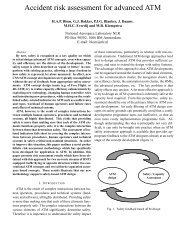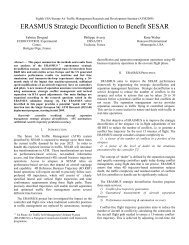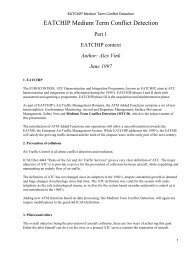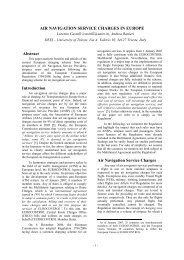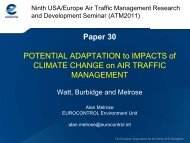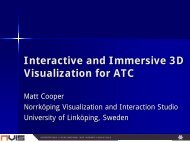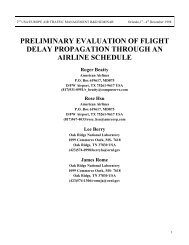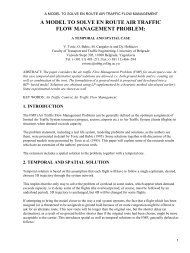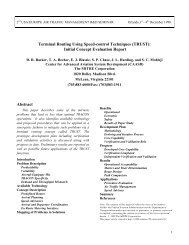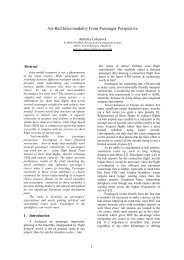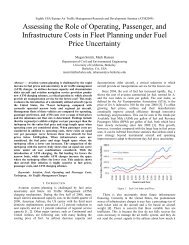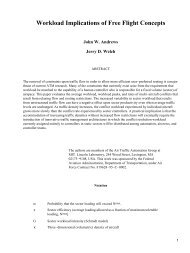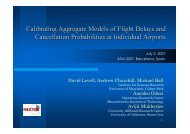• Prevention opportunities, where extendedcoverage of safety equipment or enhancedperformance by ATC or pilots would havebeen able to prevent the accident, eventhough they would not be regarded as“failures” in an accident investigation.• Indirect influences, where performance ofone element of <strong>ATM</strong> leads to errors orfailures by another element (e.g. poorcontroller performance influencing piloterrors). These exclude direct influences thatare modelled in the categories above.Causal breakdowns are expressed as“contributions” to the fatal accident frequency. Thisis a simple estimate of the maximum fractionalreduction in accident frequency that would occur ifthe causal factor were eliminated and other factorsremained constant.[4]:• Presents the 2005 baseline risk picture,showing the current overall <strong>ATM</strong>contribution to accident risks forcommercial aircraft in Europe• Describes how the 2012 risk picture hasbeen developed through quantification ofthe effects of all <strong>ATM</strong> changes that areplanned to occur by then.Validation & UncertaintiesClassical validation of the IRP model, in thesense of an independent dataset that is shown toagree with the IRP results to within an acceptablelevel of accuracy, has been up to now impracticalfor this type of causal model. This is because: (1)Most available data has been used in constructingthe model; and (2) No other model seems to becurrently able to obtain comparable results.The IRP has been validated against historicalexperience since 1990. This date was chosenbecause it is the beginning of the period for whichaccident data has been analyzed in detail. Olderdata would show more significant differences inrisks, but the aircraft and the <strong>ATM</strong> practices wouldbe less consistent with the current risk model. . Itwould be desirable to obtain more thoroughvalidation. Possible approaches include:• Validation against accident and incidentexperience in the coming years.• Retrospective prediction of risks forspecific regions or units for which there isaccident or incident data suitable forvalidation of aspects of the risk model.• Dissemination of the techniques used in theIRP through peer-reviewed journals orother risk studies.• Evaluation of independent proposals forimproving accident safety. If these wereeither consistent with conclusions from theIRP or different for a clear reason, thiscould be considered a validation of it.• Expert review of the conclusions from theIRP. If the recommendations from the IRPwere supported by industry experts, thiscould also be considered a validation of theIRP.A comprehensive uncertainty analysis,obtaining confidence limits on all the IRP results,would be time-consuming to perform. It would alsobe complex to present, as each of the above resultswould be replaced by a probability distribution,although this could be summarized as a median andtwo representative confidence limits. In the presentwork, illustrative sensitivity tests have been carriedout and the following conclusions are based onthese.• The overall fatal accident frequencies arebased on an average of 13 accidents peraccident category, consisting of the relevantevents in the overall accident dataset. Ifoccurrences follow a Poisson distribution,the 90% confidence ranges for thefrequencies would be from approximately0.6x to 1.6x the estimated values. Similaruncertainties will apply to the ICAOaccident frequencies, since they have beenderived from the fatal frequencies, not fromindependent larger datasets.• The individual causal factors are each basedon an average of approximately 3 incidents,which are the relevant events in the overallaccident and incident dataset. Ifoccurrences follow a Poisson distribution,the 90% confidence ranges for thecontributions would be from approximately0.25x to 3x the estimated values. In futurework, it would be desirable to reduce theseuncertainties by analysing more accidentsand incidents.• The contributions for the <strong>ATM</strong> elements orfor <strong>ATM</strong> as a whole combine thecontributions from several causal factors.Provided the uncertainties in thecomponents are independent, this will tendto reduce the uncertainties in the summedvalues. As a rough indication, it is judged6
that the 90% confidence ranges for theoverall <strong>ATM</strong> contributions would be fromapproximately 0.5x to 2x the estimatedvalues. These uncertainties could beexplored further through sensitivity tests onselected key results.Use Cases sing StylesThe IRP may be used in many different ways,each requiring different types of results. Thefollowing use cases are being considered presently:Strategic direction for safety improvementsand safety research: For this, the baseline riskpicture indicates the priorities and key safety issues.Safety impacts of individual <strong>ATM</strong> changes:For the 2012 benchmark, the IRP has modeled thesafety impacts of all known <strong>ATM</strong> changes, and thedetailed results include a high level qualitativeidentification of their main safety benefits andhazards, as well as a model of their quantitativeeffects.Overall safety target compliance: Based oncurrent assumptions, the results for 2012 show thatin order to comply with the <strong>ATM</strong> 2000+ target ofno increase in the number of <strong>ATM</strong> inducedaccidents, it will be necessary to implement all theplanned <strong>ATM</strong> safety improvements by 2012.Comparison with the ESARR4 [5] target of 1.55 x10 -8 per flight hour for <strong>ATM</strong> contributions issensitive to the precise definitions used, but itwould be necessary to select additional safetyimprovements beyond 2012 to achieve compliance.Safety target apportionment: Once theoverall <strong>ATM</strong> risks for the future case meet theoverall target, the modeled performance of each<strong>ATM</strong> element can be used as its safety objective.Thus IRP provides a convenient way ofapportioning safety targets that takes account ofactual attainment and interactions with expectedfuture developments.Risk picture for specific units: The IRP hasthe capability to make predictions of risks for aspecific unit (airport, airspace or individual flight).However, this capability requires validation.Consistency of safety cases: The IRP faulttree model can be recast as a standard event tree fordifferent types of failures, which can help achieveconsistency in the modeling for safety assessmentsof individual projects.Safety roadmap: The IRP can be used tomake risk predictions for individual <strong>ATM</strong> changesand groups of <strong>ATM</strong> changes, combined withdifferent implementation dates or growths in safetynet usage. This allows definition of a sequence of<strong>ATM</strong> changes to ensure that risks are decreased assoon as possible.Alignment of severity classifications: TheIRP includes a set of incidents of differentseverities, which are precursors of each accidentcategory. These can be used to derive quantitativetargets consistent with the ESARR4 severityclassification.Safety performance monitoring: Theprecursor incidents are also suitable for monitoringof trends in actual safety performance, as well asnew data gathering to validate and improve the IRP.Conclusions and further workThis type of risk modeling is challenging andnot yet fully mature. At present, the results aresensitive to interpretations. For instance, IRP 2005presents point estimates of the contributions of<strong>ATM</strong> elements to aviation risks. Some of these arebased closely on large, well-established datasets,whereas others are based on uncertain judgments. Itwould be desirable if the source of the data(pedigree) could be made plain, along with thecollected results of sensitivity analyses, and ifpossible the degree of uncertainty in the resultscould be estimated. It will not be possible to showthis information succinctly for all results, but itwould be possible to develop a format that showedall necessary information for selected results.However, it is believed that the IRP is suitable forthe wide range of intended uses andrecommendation of safety improvements.Progressive improvement would still be desirablethrough analysis of further data, incorporation ofexpert judgments, alternative validation exercises,improvements in user-required capabilities, andimproved consistency with safety targets.Over 2007-2008, the major development willconsist in developing the IRP into a tool that canshow how risks will be affected as the OperationalImprovements (OIs) are implemented and trafficgrows. IRP 2005/2012 predicts the current andfuture risk, but is not optimized to show thechanges in risk between these points and explorealternative implementation strategies to minimizerisks. The so-called Safety Roadmap will addressthe definition of the sequence of changes betweenthe present and the planned future <strong>ATM</strong> system, sothat the safety target is met at all stages, and inparticular that risks are decreased where possible.It will enable to appraise whether the predictedsafety improvements throughout the period are notoutweighed by the extra traffic. Ultimately, theRoadmap will include safety monitoring targets, sothat as OIs are introduced, it can be determined ifexpected safety impacts are realized, exceeded, or7



